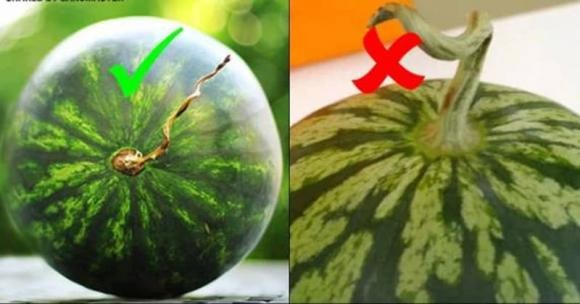Many people believe that when buying watermelon, you should listen to the sound it makes when tapped on the rind. If the watermelon makes a dull sound, it is said to be ripe and sweet. If the sound is more hollow, it is a sign that the watermelon is still young. If you hear a thud sound, it means that the watermelon is overripe and the flesh is mushy. However, some people find it difficult to choose a ripe and sweet watermelon just by tapping on it.

Therefore, instead of relying on the sound of the watermelon, you can examine the appearance of the watermelon to make a better choice.
Choose the bottom part of the watermelon with blemishes and yellow spots
Take a closer look at the color of the watermelon rind. Watermelons that come into contact with the ground often have dark yellow blemishes. Young watermelons will have a greenish-yellow rind, while ripe watermelons will have a golden yellow rind. The yellow spots or orange-yellow color on the bottom part of the watermelon indicate that it is a sweet and ripe watermelon.
The watermelon’s blossom end
Look at the blossom end of the watermelon to assess its sweetness. The blossom end is the part of the watermelon that is opposite to the stem, where the flower of the watermelon has fallen off. If the blossom end of the watermelon is large, it indicates that the rind will be thick and the flesh will be less sweet. If the blossom end is small, it means that the watermelon has a thin rind and the flesh is sweet enough. Therefore, choose a watermelon with a small and slightly sunken blossom end for the best flavor.
Check the veins on the watermelon rind
Ripe watermelons will have clear and evenly distributed veins. Watermelons with small and uneven veins or veins that are broken indicate that they are still young and not sweet enough.
Spots on the rind
The brown spots on the watermelon rind are not a sign of spoilage. They are marks left by bees pollinating the flowers. Watermelons with distinct and numerous brown spots have been pollinated multiple times. Such watermelons tend to be sweeter.
Watermelon size
Avoid choosing watermelons that are too large or too small. Watermelons with medium size, weighing between 1.5-3kg, are considered ideal.
Male watermelons are juicier, while female watermelons are sweeter
Male watermelons are usually larger, elongated in shape, and juicier. On the other hand, female watermelons are rounder, sweeter, and have fewer seeds. Another way to differentiate between male and female watermelons is by looking at the bottom part of the fruit. Male watermelons will have a small circular mark about the size of a coin, while female watermelons will have a larger and more distinct circular mark.

Choose a juicy and delicious watermelon
Examine the stem of the watermelon
However, it is important to observe carefully as there are cases where the stem of the watermelon withers due to detachment, indicating that it is still young and not fully ripe, resulting in a bland taste.
9 Gorgeous Ways to Decorate a Mid-Autumn Festival Table
With the traditional Mid-Autumn Festival comes a long-time beloved activity – breaking the tray! Every year, children look forward to this exciting event, and what makes it even more fun is the brightly-colored, fruit-laden trays that make for an unforgettable childhood memory. If you’re interested in creating your own beautiful Mid-Autumn tray this year, then let us show you some of our favorite decorations!




































